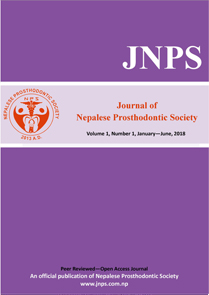A Comparative Study of Microorganisms Adhered to Different Surfaces of Temporary Removable Partial Dentures
DOI:
https://doi.org/10.3126/jnprossoc.v1i1.23845Keywords:
Adherence, denture microorganisms, denture plaque, surface of dutures, temporary dentureAbstract
Introduction: The purpose of this study was to identify and compare aerobic microorganisms adhering to polished and tissue surfaces of temporary removable partial dentures at 24hrs and at one week of dentures in use.
Materials and methods: A total of 31 patients visiting the department of Prosthodontics for temporary removable partial dentures without any known systemic and oral diseases were included in the study. Dentures were fabricated according to the standard prosthodontic procedures accepted in the department. Each patient was examined twice, once after 24hrs of denture insertion, and then at oneweek of use wherein plaque samples were collected from the polished surface and the tissue surface. The samples were taken to the microbiology lab for microbiological investigations within half an hour of sample collection and different microorganisms were identified.
Results: Microorganisms identified at 24 hours from polished and tissue surfaces of the dentures were same in type and not significantly different in frequency of isolation. They were Streptococcus spp., Staphylococcus spp., Acinetobacteranitratus, Enterobacter cloacae, Pseudomonas aeruginosa, Citrobacterfreundii and Candida albicans. Those identified at one week of dentures in use, from the two surfaces were same in type but three new types of microorganisms, Klebsiella pneumonia, Escherichia coli, and Proteus vulgaris were also found. There was a significant difference in the isolation frequency of Staphylococcus spp. from the two surfaces.
Conclusion: Same types of microorganisms adhere to both the surfaces but significant differences may occur in frequency of isolation. With time dentures favour colonization of new microorganisms.
Downloads
Downloads
Published
How to Cite
Issue
Section
License
This license enables reusers to distribute, remix, adapt, and build upon the material in any medium or format, so long as attribution is given to the creator. The license allows for commercial use. © The authors




